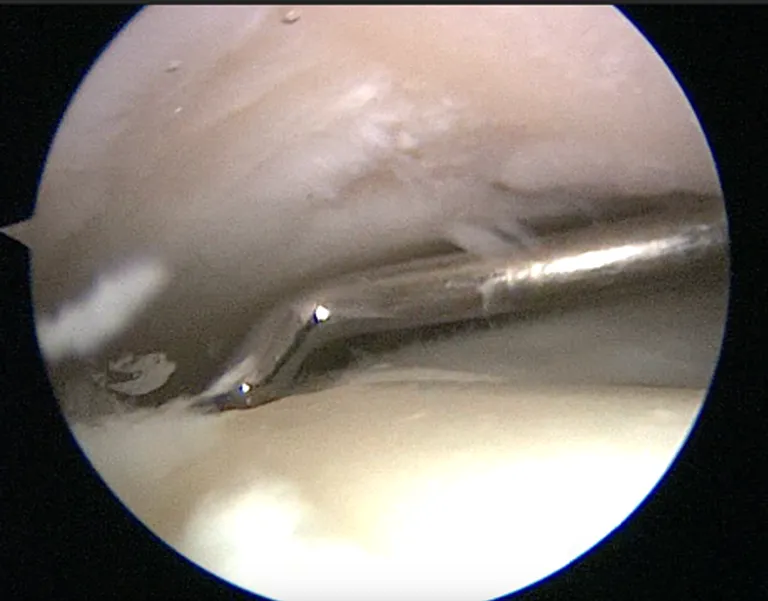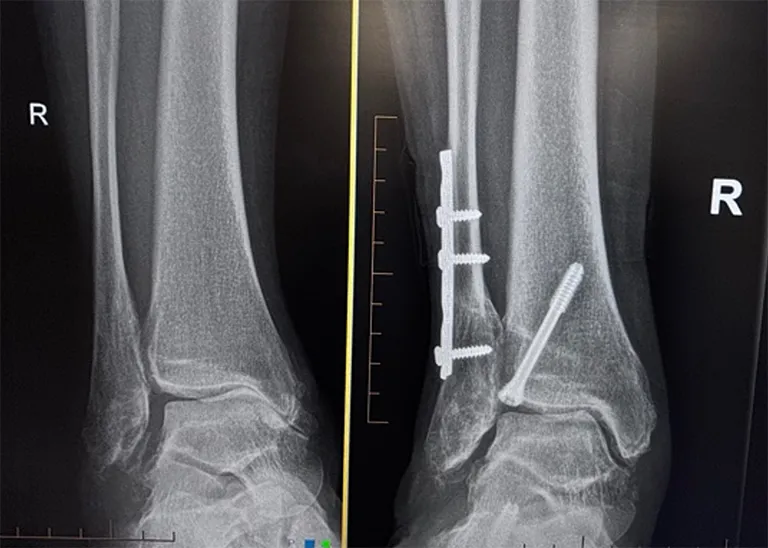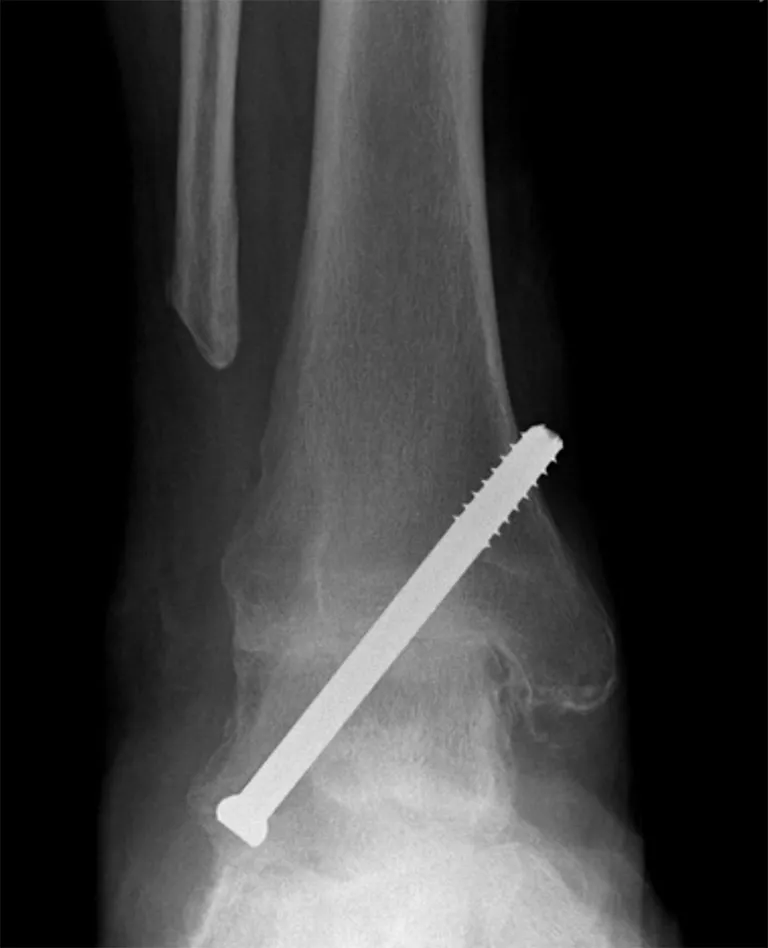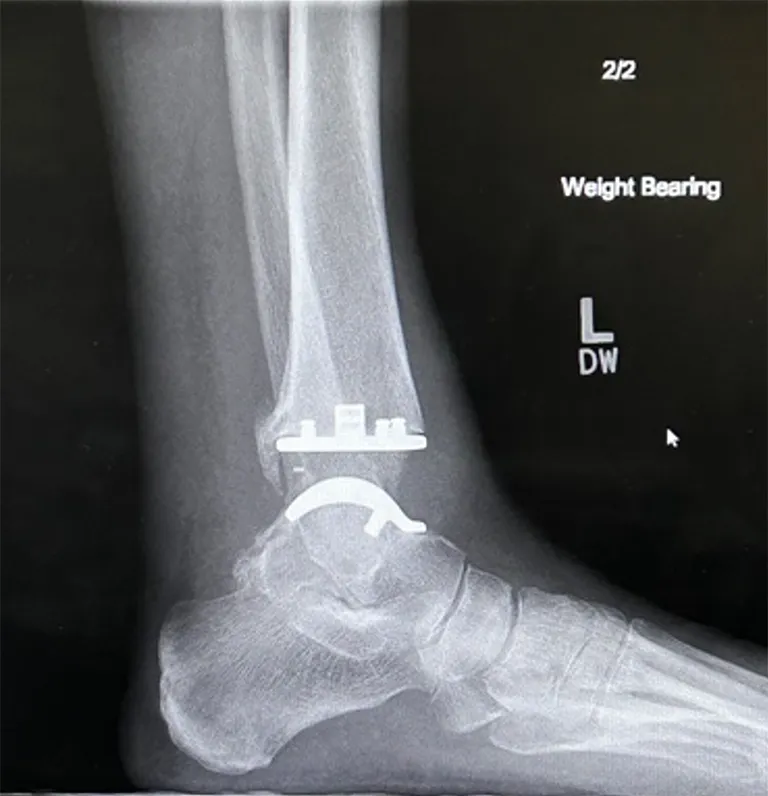Surgical Options for Ankle Arthritis
When non-surgical treatments are no longer effective and ankle arthritis significantly limits your quality of life, surgery may offer lasting pain relief and improved function. Below is a detailed overview of the three main surgical options used to treat ankle arthritis.
1. Arthroscopic Debridement
(Minimally Invasive “Joint Clean-Up”)
What it is:
A keyhole (arthroscopic) procedure where a camera and instruments are inserted into the ankle joint through small incisions. Surgeons remove loose cartilage, bone spurs, scar tissue, and inflamed joint lining to reduce pain and improve movement. The recovery is very quick and there is no need for plastercast or a period non-weightbearing.

Pink areas are bare bone. White areas are remaining cartilage.
Best for:
- Early-stage arthritis, where there is still remaining cartilage
- Patients with mechanical symptoms like catching, locking, or impingement
- This is not a cure, but can delay the need for major surgery – in some cases this can give years of pain relief
Anaesthesia:
- General anaesthesia
Hospital stay:
- Day surgery
Recovery timeframe:
- Immediate weightbearing in a boot
- 1-2 weeks in a walking boot or supportive shoe
- Return to most activities by 6–8 weeks, depending on swelling and comfort
Outcomes:
- Success rate: 60–70% short- to mid-term relief of perhaps 1-5 years
- May delay need for more definitive surgery (fusion or replacement) by several years
- Less effective in moderate to severe arthritis
- Rarely the arthritic pain is made worse
2. Realignment Osteotomy
(Joint-preserving realignment of the bone to offload the worn part of the joint)
What it is:
This procedure involves cutting and repositioning the tibia or fibula to shift weight away from the damaged part of the ankle joint to a healthier area. The bone is then fixed in its new position using plates or screws.
I perform this surgery using Minimally Invasive techniques, which minimises the scars and surgical damage to the soft tissues, speeding recovery and reducing the risks of wound complications and infection.
Often I will combine this with a minimally invasive realignment of the heel to provide optimum correction. See Distal Tibial Realignment Osteotomy.

Best for:
- Asymmetric arthritis, especially if caused by malalignment (e.g. varus or valgus deformity)
- Younger, active patients aiming to delay fusion or replacement
- Those with preserved cartilage in part of the joint
Anaesthesia:
- General anaesthetic with regional nerve block
Hospital stay:
- Daycase or 1 Night
Recovery timeframe:
- Weightbearing: 4 weeks non-weightbearing in a protective boot, then gradual increased weightbearing for next 4 weeks
- 3 months for normal daily activity, 6 Months light sports, 9 Months full sport
Outcomes:
- Success rate: 70–85% experience long-term improvement
- Can delay need for joint-sacrificing surgery by years
- Typically provides significant improvement in pain, but the underlying joint likely to still give symptoms
Considerations:
- Requires reasonable area of healthy cartilage, perhaps 30-50% remaining
- Long recovery
- Symptoms reduced but not usually relieved
- Does not affect later options
3. Ankle Fusion
(Also called Ankle arthrodesis)
What it is:
The damaged joint surfaces are removed and the ankle bones (tibia and talus) are fused together with screws or plates, eliminating motion at the joint. This relieves pain by stopping bone-on-bone movement.
The surgery can be performed open or arthroscopically using minimally invasive surgery techniques. This will depend on the severity of the arthritis and particularly if there is major deformity or bone loss.

Open Arthrodesis:
This is performed through a 15cm incision over the outer side of the ankle. The arthritic joint surfaces are excised (cut out) and the joint fixed together with screws or plates. Often the lower fibula is removed to access the joint. The operation takes approximately 2 hours. See Open Ankle fusion.
Indications:
- End stage arthritis
- Severe deformity or Bone loss
- After previous infection

Arthroscopic Arthrodesis:
This is the procedure I perform most commonly for ankle arthritis. It is performed with key-hole techniques, through 3 small incisions. The arthritic joint surfaces are removed using arthroscopic burrs and the joint fixed together with titanium screws. The operation takes approximately 1.5 hours. See Arthroscopic Ankle fusion.
Best for:
- End-stage arthritis
- Patients with high physical demands or poor bone quality
- Those with extensive scarring or poor tissues


Anaesthesia:
- General anaesthesia combined with regional nerve blocks
Hospital stay:
- Typically daycase or 1 night, depending on pain and mobility
Recovery timeframe:
- 4 weeks non-weightbearing – the first 2 weeks in a cast then in a boot
- Gradual return to normal walking over 3–4 months
- Full recovery: 9–12 months for strength and comfort
Outcomes:
- Excellent long term pain relief in 85–95% and stable walking
- Fusion is durable and permanent
- No ankle movement, but most people adapt well with rocker-bottom shoes
- May cause stress on nearby joints (e.g., subtalar joint) over time
4. Total Ankle Replacement (TAR)
(Also called Ankle Arthroplasty)
What it is:
The worn-out joint surfaces are removed and replaced with a metal and plastic implant that mimics the natural joint, preserving motion while relieving pain. Identical to the materials used in Knee & Hip replacement.
This is the operation I perform most commonly for ankle arthritis now. One of the major benefits is that full weightbearing is allowed immediately. Performing this for over 20 years, the long term results have been excellent. See Total Ankle Replacement

Best for:
- End-stage arthritis
- Patients over age 55–60
- Patients unable to cope non-weightbearing
- Concomitant joint problems above or below the ankle
- Those wanting to preserve ankle motion and avoid the limitations of fusion
Anaesthesia:
- General or spinal anaesthetic, often with a regional block
Hospital stay:
- Usually daycase or 1 night
Recovery timeframe:
- Immediate weightbearing in a protective boot for 4 weeks
- Walking long distances possible by 2-3months
- Full recovery: 6-9 months, with swelling potentially lasting longer
Outcomes:
- Success rate: 90% excellent results at 10yrs and beyond
- Better function than ankle fusion with more normal walking
- Joint motion preserved and protection of other joints (unlike fusion)
- May require revision surgery later if implant loosens or wears out